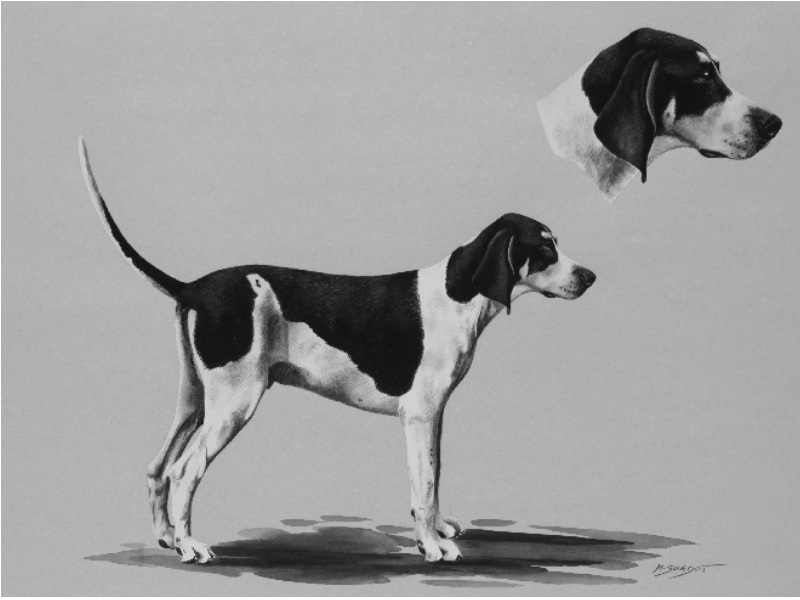 | Fédération Cynologique Internationale |
FCI-Standard N° 323
Great Anglo-French White and Black Hound
(Grand Anglo-Français Blanc et Noir)
These illustrations do not necessarily show the ideal example of the breed.
The sequence might differ slightly from the original breed standard.
ORIGIN
: France.DATE OF PUBLICATION OF THE OFFICIAL VALID STANDARD
: 04.11.2008.UTILISATION
: Pack Hound for big game.FCI-CLASSIFICATION
:| Group 6 | Scent hounds and related breeds |
| Section 1.1 | Scenthounds, Large-sized Hounds |
| With working trial | |
TRANSLATION
: Revised by J. Mulholland (2008) in collaboration with R. Triquet.BRIEF HISTORICAL SUMMARY
: This breed originates from the “Bâtard Anglo-Saintongeois”, a type which appeared in the middle of the XIXth century and which was the result of crossing between the Saintongeois and the Foxhound. The breed presently counts approximately 2000 subjects with around 200 births per year. It makes up the packs of twenty or more deer hunts and one stag hunt.The 2007 text was drafted by M. Pierre Astié, President of the “Club du chien d’ordre” and his committee, in collaboration with Mr. Raymond Triquet.
GENERAL APPEARANCE
: Big, rather powerful dog, resistant and robust with strong bone which is a reminder of his Gascon-Saintongeois origins.IMPORTANT PROPORTIONS
:The muzzle is slightly shorter than the skull.
The length of the body, from the point of the shoulder to the point of buttock, is equal to the height at the withers.
BEHAVIOUR / TEMPERAMENT
: Excels in hunting stag and deer on damp or bushy terrain. It is a friendly dog, close to humans and easy to manage in the kennels.HEAD
: Strong, rather short with skull/muzzle lines parallel..CRANIAL REGION
:Skull
: Rather flat and broad, occipital protuberance hardly marked, superciliary arches prominent.Stop
: Well defined.FACIAL REGION
:Nose
: Black, developed and rather raised. Nostrils well open.Muzzle
: Straight and a little less long than the skull.Lips
: The flews are distinctly square, seen from the side; the upper lip overlaps the lower lip well.Eyes
: Brown, relatively deep-set but not excessively.Ears
: Set-on rather broad and at eye level; relatively flat at set-on then curling towards the end; of medium length.. When pulled forward, they should not reach further than two fingers before the base of the nose leather. The tips are rather pointed.NECK
: Strong, rather short. A slight dewlap is tolerated.BODY
:Back
: Straight and well sustained..Loin
: Quite broad, rather short.Croup
: Slightly sloping;hips quite broad.Chest
: Chest: Broad and well let down to the point of the elbow.Ribcage: Moderately rounded.
Underline and belly
: Slightly tucked up.Flank
: Well filled.TAIL
: Strong at its root, tapering to a slender point, long and straight; in action, it is carried above the topline but not vertical.LIMBS
:FOREQUARTERS
: In line with the body; more round than flat.Shoulder
: Long and well muscled.Elbow
: Close to the body.Forearm
: Upright.Pastern
: Very slightly sloping, seen from the side.FEET
:Forefeet
: Thick and big, rather round.Hind feet
: Thick and big, rather round..HINDQUARTERS
: Parallel, seen from behind.Thigh
: Well let down, muscled but not over developed.Hock
: Only slightly bent , seen from the side.GAIT / MOVEMENT
: Effortless. Preferred gait supple and extended gallop.SKIN
: White under white hair, black under black hair with sometimes patches on the belly and inner thighs of blue or pale blue colour.COAT
:HAIR
: Short, quite strong and dense.COLOUR
:Obligatory white and black, with a black mantle and black markings more or less spread out which may show black or bluish speckles, or even tiny tan freckles but the latter only on the limbs. A pale tan dot above each eye as well as pale tan on the cheeks, below the eyes, below the ears. The “roebuck mark” on the thigh is rather frequent.
Height at the withers Males 65 to 72 cm
Females 62 to 68 cm.
With tolerance of +/- 1cm.
FAULTS
: Any departure from the foregoing points should be considered a fault and the seriousness with which the fault should be regarded should be in exact proportion to its degree and its effect upon the health and welfare of the dog.SERIOUS FAULTS
:Nose: Important lack of pigmentation.
Jaws: Overshot or undershot.
Eyes: too light in colour.
Ears: dictinctly curled, too long.
Dewlap: Excessive.
Colour on the cheeks, black extending to the lips.
DISQUALIFYING FAULTS
:Aggressive or overly shy.
Frail.
Severe deviation of limbs.
Long Feet.
Tricolour coat.
Any dogs clearly showing physical or behavioural abnormalities shall be disqualified.
